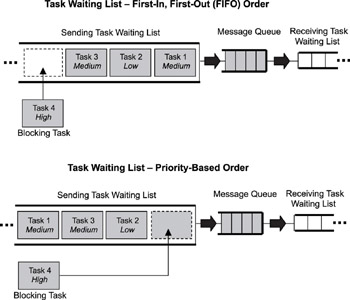Книга: Real-Time Concepts for Embedded Systems
7.6.2 Sending and Receiving Messages
Разделы на этой странице:
7.6.2 Sending and Receiving Messages
The most common uses for a message queue are sending and receiving messages. These operations are performed in different ways, some of which are listed in Table 7.2.
Table 7.2: Sending and receiving messages.
| Operation | Description |
|---|---|
| Send | Sends a message to a message queue |
| Receive | Receives a message from a message queue |
| Broadcast | Broadcasts messages |
Sending Messages
When sending messages, a kernel typically fills a message queue from head to tail in FIFO order, as shown in Figure 7.4. Each new message is placed at the end of the queue.

Figure 7.4: Sending messages in FIFO or LIFO order.
Many message-queue implementations allow urgent messages to go straight to the head of the queue. If all arriving messages are urgent, they all go to the head of the queue, and the queuing order effectively becomes last-in/first-out (LIFO). Many message-queue implementations also allow ISRs to send messages to a message queue. In any case, messages are sent to a message queue in the following ways:
· not block (ISRs and tasks),
· block with a timeout (tasks only), and
· block forever (tasks only).
At times, messages must be sent without blocking the sender. If a message queue is already full, the send call returns with an error, and the task or ISR making the call continues executing. This type of approach to sending messages is the only way to send messages from ISRs, because ISRs cannot block.
Most times, however, the system should be designed so that a task will block if it attempts to send a message to a queue that is full. Setting the task to block either forever or for a specified timeout accomplishes this step. (Figure 7.5). The blocked task is placed in the message queue’s task-waiting list, which is set up in either FIFO or priority-based order.

Figure 7.5: FIFO and priority-based task-waiting lists.
In the case of a task set to block forever when sending a message, the task blocks until a message queue element becomes free (e.g., a receiving task takes a message out of the queue). In the case of a task set to block for a specified time, the task is unblocked if either a queue element becomes free or the timeout expires, in which case an error is returned.
Receiving Messages
As with sending messages, tasks can receive messages with different blocking policies-the same way as they send them-with a policy of not blocking, blocking with a timeout, or blocking forever. Note, however, that in this case, the blocking occurs due to the message queue being empty, and the receiving tasks wait in either a FIFO or prioritybased order. The diagram for the receiving tasks is similar to Figure 7.5, except that the blocked receiving tasks are what fills the task list.
For the message queue to become full, either the receiving task list must be empty or the rate at which messages are posted in the message queue must be greater than the rate at which messages are removed. Only when the message queue is full does the task-waiting list for sending tasks start to fill. Conversely, for the task-waiting list for receiving tasks to start to fill, the message queue must be empty.
Messages can be read from the head of a message queue in two different ways:
· destructive read, and
· non-destructive read.
In a destructive read, when a task successfully receives a message from a queue, the task permanently removes the message from the message queue’s storage buffer. In a non-destructive read, a receiving task peeks at the message at the head of the queue without removing it. Both ways of reading a message can be useful; however, not all kernel implementations support the non-destructive read.
Some kernels support additional ways of sending and receiving messages. One way is the example of peeking at a message. Other kernels allow broadcast messaging, explained later in this chapter.
- 9.4.1.Messages
- 8.4.2. Sending and Receiving Messages
- Разработка приложений баз данных InterBase на Borland Delphi
- Open Source Insight and Discussion
- Introduction to Microprocessors and Microcontrollers
- Chapter 6. Traversing of tables and chains
- Chapter 8. Saving and restoring large rule-sets
- Chapter 11. Iptables targets and jumps
- Chapter 5 Installing and Configuring VirtualCenter 2.0
- Chapter 16. Commercial products based on Linux, iptables and netfilter
- Appendix A. Detailed explanations of special commands
- Appendix B. Common problems and questions




